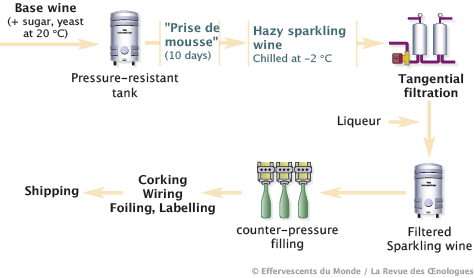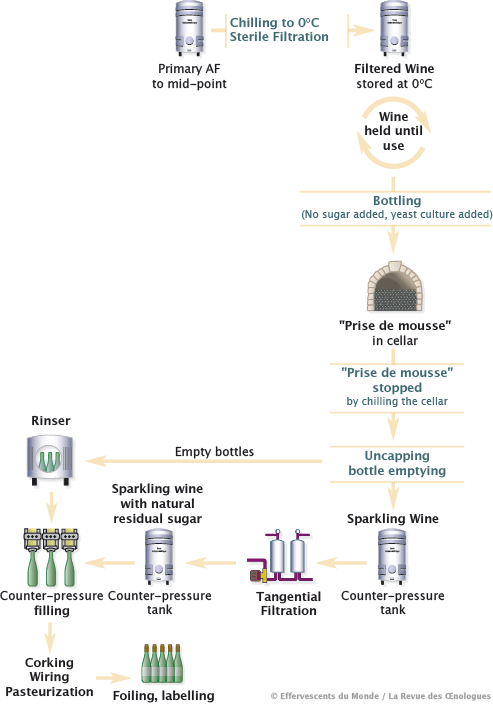



Method | Transfer
-
Phase 1 : Making the base wineClassic white winemaking techniques
-
Phase 2 : Transforming the still base wine into an effervescent/sparkling wine.
-
The secondary fermentation (“prise de mousse”) and ageing are done in bottles, as in the traditional method.
-
There are no riddling or disgorging operations.
-
The bottles are emptied by direct siphoning, and the gassy wine is kept under pressure and stored in tanks.
-
The wine is filtered under pressure and pumped back to the tanks, where the dosage liqueur is added.
-
The wine is transferred to pre-rinsed bottles with its original CO2 gas. This operation is performed with a counter-pressure filler.
-
The bottles are immediately corked and wired.
Method | Ancestral – Sparkling Wines Produced by Spontaneous Fermentation
This method, which can be quite difficult to control, is still used in the French appellations of Limoux, Gaillac, Bugey and Cerdon…
It is likely that this was the first method developed for making effervescent/sparkling wines.
-
Phase 1 : Making the base wineClassic white winemaking techniques
-
Phase 2 : Transforming the still base wine into an effervescent/sparkling wine.
-
The secondary fermentation (“prise de mousse”) occurs in bottles without addition of sugar (no tirage liqueur or expedition liqueur).
-
The “prise de mousse” is stopped simply by yeast cell depletion. The deposit is insignificant in volume and is not ejected from the bottle. In other words, there is no disgorging.
-
With this method, the action of the native or cultured yeast cells is controlled or stopped by:
-
Depletion of the medium or of nutrients, low temperature.
-
Depletion of the medium or filtration, sulphur dioxide addition.
-
Method | Dioise / Asti Spumante
The basic principle is the same as for the ancestral method.
All the sugar comes from the grapes. The process is controlled by very sophisticated, modern equipment and techniques. In essence, it is the ancestral method made safer by elements from the transfer method. Chilling and filtration are the two methods used to regulate yeast action.
-
Final alcohol content : 9.5% vol.
-
Residual sugar : around 50 g/L
The Drôme Valley and the Diois region in France are examples of regions where this method is used:
-
Clairette de Die.
-
Asti Spumante in Italy
Method | Closed Tank
Principles
In contrast with the other methods, this process replaces the bottle with a pressure-resistant steel tank. This tank is in effect one gigantic bottle containing several thousand litres of wine.
Sugar and yeast are added to the base wine, which is kept at a temperature of 20°C. The secondary fermentation (“prise de mousse”) lasts only 10 days. Once it is completed, the sparkling wine is chilled to -2°C in order to stabilise it and reduce its effervescence. It is filtered at low temperature, transferred to a buffer tank to preserve its carbon dioxide content and then bottled with a counter-pressure filler.
The counter-pressure in the buffer tank and at bottling is provided by exogenous carbon dioxide. There is no mixing between the CO2 in the wine and the exogenous CO2. At the filler outlet, the bottles are immediately corked and wired.
-
Phase 1 : Preparing the base wineClassic white winemaking techniques
-
Phase 2 : Making the sparkling wineSee the figure below.
-
Method | Continuous or Russian Method
Principles
The secondary fermentation (“prise de mousse”) is a slow, continuous process. After addition of sugar and yeast, the wine is circulated through a series of fermentation tanks. These tanks contain rings with a proprietary composition, or more simply they are filled with oak chips. The yeast cells adsorb to these rings or chips and ferment the sugar as the wine circulates around them. At the outlet of this series of fermentors, the wine contains only a few dead yeast cells. It is effervescent and sparkling.
A chilling and CO2 stabilisation phase follows the “prise de mousse”.
This process operates 24 hours a day. Prior to bottling, the new sparkling wine is stored in a buffer tank.
Bottling is done with a counter-pressure filler. Corking and wiring are performed at the filler outlet.
Method | Carbonation
Principle
There is no secondary fermentation (“prise de mousse”) in this method. The CO2 gas is exogenous. It is continuously added to the wine stream, which has already been stabilised and chilled to -2 °C. This process is continuous.
The CO2 gas comes from a reserve tank, which holds the gas at high pressure. Only food-grade CO2 gas is used. The gas pressure is reduced, and the gas is added proportionally to the wine (brut, demi-sec, sweet, etc.) in a vessel known as a saturator. A fritted metal capsule with very small pores is used in order to distribute the gas in fine streams. The gas dissolves instantaneously and extensively in wine. The excess gas in the wine is compressed upon bottling, and effervescence will appear when the bottle is opened. At the saturator outlet, the wine is immediately bottled with a counter-pressure filler.
The bottles are immediately corked and wired. The carbonation is continuous when the line is in service.
Dissolving a certain quantity of CO2 gas in dry or sweet wines using liquefied CO2 is known as carbonation.
Wine Types :
In France, carbonated wines cannot be labelled with an appellation name (AOC), and they cannot be entered in the Effervescents du Monde competition since they contain exogenous CO2.
-
Phase 1 : Making the base wine Classic still white winemaking techniques.
-
Phase 2 : Making the effervescent/sparkling wine.See the figure below.Carbonated semi-sparkling or pearl wine (1 to 2.5 bar at 20°C)
-
Carbonated sparkling wine (greater than 3 bar at 20°C)P
-
The secondary fermentation (“prise de mousse”) occurs in bottles without addition of sugar (no tirage liqueur or expedition liqueur).
-
The “prise de mousse” is stopped simply by yeast cell depletion. The deposit is insignificant in volume and is not ejected from the bottle. In other words, there is no disgorging.
-
With this method, the action of the native or cultured yeast cells is controlled or stopped by:
-
Depletion of the medium or of nutrients, low temperature.
-
Depletion of the medium or filtration, sulphur dioxide addition.
-
-

